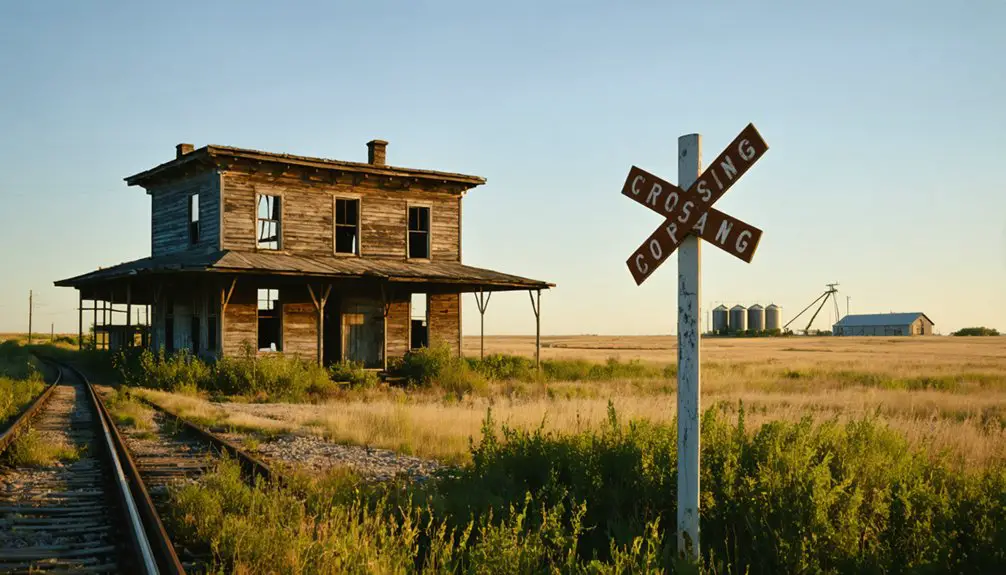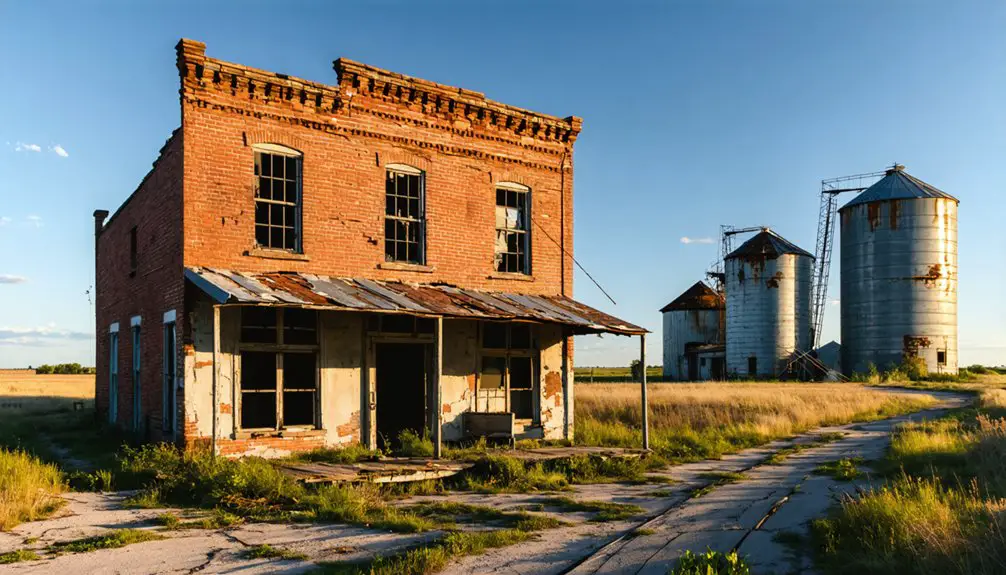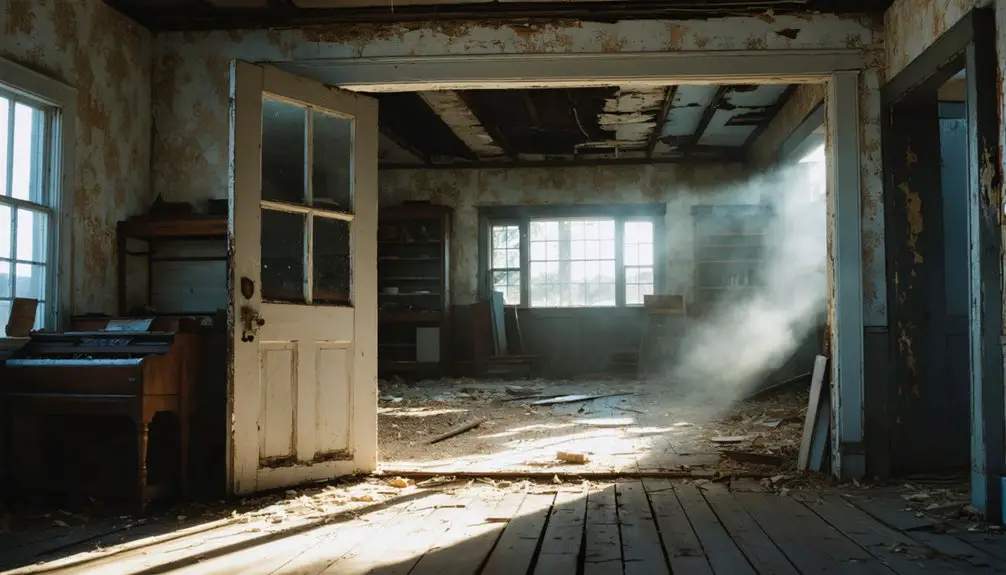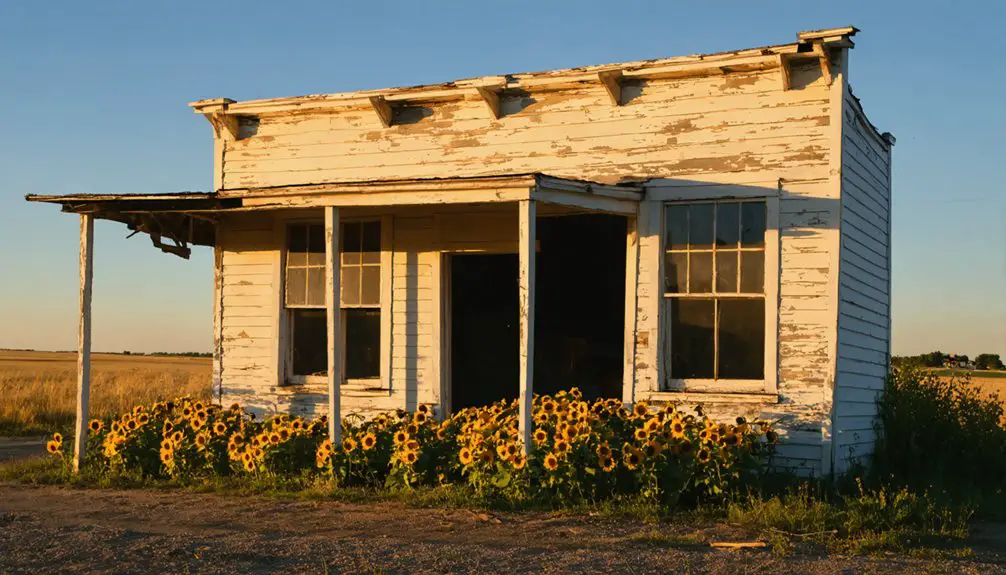You’ll find Buchanan, Kansas transformed from a thriving railroad town into a ghost town over its century-long history. Initially named Weeks, this Missouri Pacific Railroad stop grew to 1,258 residents by 1880, prospering through stone quarries and agriculture. The town’s fortunes declined after the 1957 depot closure, with younger residents leaving for urban opportunities. Today, Queen Anne Victorians and iron-corniced buildings stand as silent witnesses to Buchanan’s frontier legacy, while preservation efforts continue uncovering its fascinating past.
Key Takeaways
- Buchanan began as a thriving railroad town in late 19th century Kansas, with its peak population reaching 1,258 residents by 1880.
- The town’s economy was built on stone quarries and agriculture, supported by the Missouri Pacific Railroad’s freight network.
- The closure of the railroad depot in 1957 marked a significant turning point in Buchanan’s decline toward ghost town status.
- Agricultural mechanization, farm consolidation, and urban migration contributed to the town’s population loss and eventual abandonment.
- Historical remnants include Queen Anne Victorian homes, iron cornices on commercial buildings, and stone structures from its industrial past.
Origins of a Railroad Town: From Weeks to Buchanan
As railroad development swept through Kansas in the late 19th century, the establishment of towns along the tracks became a common occurrence that would shape the region’s future.
You’ll find that the town origins of Buchanan followed a familiar pattern, where railroads strategically positioned their stations to maximize their influence on local development.
Like many railroad towns of the era, the settlement’s identity evolved through name changes that reflected its growing connection to the rails. The area was initially called Weeks after the local landowner who donated the property.
Railroad settlements often shed their original names as they grew, adopting new identities tied to their railway heritage.
The development of infrastructure, including depots and water tanks, transformed the area into a hub of commerce and transportation.
As the railroad company expanded its presence, they’d build essential facilities that would serve both the growing town and the rail line itself, creating a symbiotic relationship between the settlement and the railroad that defined its early character. The Lincoln Land Company took charge of platting the land and building a prominent depot to support the growing community.
Life Along the Missouri Pacific Line
As you traveled through Buchanan in its heyday, you’d have encountered a bustling depot where the Missouri Pacific line’s daily operations centered around freight deliveries, passenger service, and telegraph communications.
The town’s commerce flourished around the railroad, with merchants operating general stores, hotels, and services that catered to both residents and travelers passing through on the MoPac trains. Like the Kansas City Suburban Belt Railway, Buchanan’s rail service played a vital role in connecting communities to larger commercial centers. With an average fourteen-hour journey between Kansas City and St. Louis, Buchanan became an important rest stop for weary passengers.
The depot served as more than just a transportation hub – it was an essential gathering place where townspeople collected mail, shared news, and socialized while waiting for incoming trains.
Railroad Operations Daily
While passenger and freight trains rumbled along the Missouri Pacific Line daily, dedicated crews faced demanding physical labor and hazardous conditions to keep operations running smoothly. The freight transport costs decreased dramatically compared to stagecoach services.
During railroad expansion, you’d find workers battling the elements while inspecting tracks, repairing infrastructure, and coordinating complex schedules across isolated stretches. Worker safety remained paramount as crews adapted to challenging terrain and managed the shift from steam to diesel locomotives. The comprehensive track rebuilding program implemented in 1973 demonstrated the ongoing commitment to maintaining safe and efficient rail operations.
- Track maintenance crews worked tirelessly to repair war-damaged bridges and rails, often in remote locations.
- Helper locomotives required strategic positioning to optimize train dynamics through river valleys and bluffs.
- Multiple shifts of engineers, conductors, and signal operators coordinated seamlessly to handle both passenger transfers and freight movement.
Town Commerce Activities
The bustling Missouri Pacific Line transformed Buchanan into a vibrant commercial hub where timber operations and agricultural trade dominated daily life.
You’d find general stores stocked with essential supplies for railroad workers, farmers, and timber crews, while freight depots hummed with activity as local producers loaded their goods for shipment.
William Buchanan’s timber commerce operations, established in 1896, relied heavily on the railroad’s freight transportation network.
The town’s merchants coordinated their inventory with train schedules, creating a rhythm of commerce that peaked during spring and fall harvests.
As the first railroad west of the Mississippi River, the Missouri Pacific’s presence since 1852 made Buchanan an attractive location for businesses and traders.
You could exchange goods at stores that doubled as trading posts, while nearby warehouses stored products awaiting shipment.
Banking services, equipment repair shops, and boarding houses completed the commercial ecosystem that kept Buchanan’s economy flowing along the Missouri Pacific Line.
Community Gathering Places
Life along the Missouri Pacific Line centered around vibrant gathering spots where Buchanan’s residents forged lasting social bonds. The railroad heritage shaped the town’s social fabric, with the depot serving as more than just a transportation hub – it was where you’d exchange news, collect mail, and catch up with neighbors while waiting for trains. The daily hourly train schedule from early morning to late evening made the depot a natural meeting point throughout the day. The Sunshine Special train became a beloved sight for residents after its introduction in 1915, bringing excitement to the depot whenever it passed through.
- The depot’s waiting room doubled as an informal meeting space, hosting everything from casual conversations to impromptu community meetings.
- Churches and schools strategically built near the rail line made it easier for rural families to participate in community life.
- Local halls and gathering spaces near the tracks hosted dances, traveling performers, and social clubs, creating lasting social memories.
These communal spaces strengthened ties between railroad workers’ families and local residents, creating a close-knit community defined by the rhythm of train schedules.
Economic Pillars and Local Industries
Buchanan’s economic foundation rested heavily on railroad shipping operations that connected local agricultural producers to broader markets, with the Union Pacific Railroad’s presence enabling both livestock and grain transport.
You’ll find evidence of the town’s role as an agricultural trade hub in its grain elevators and stockyards, which served regional farmers and ranchers throughout the late 19th century.
While documentation of stone quarry activity exists, it played a supplementary role to the primary economic drivers of cattle shipping and grain commerce that defined Buchanan’s peak period. Like many western settlements, the town’s eventual decline accelerated when rail access was lost, forcing businesses and residents to relocate.
Railroad Shipping Operations
Operating at the heart of regional commerce, railroad shipping transformed Buchanan into an essential transportation hub through its extensive network of tracks, stations, and maintenance facilities.
You’ll find the town’s railroad logistics were masterfully coordinated, with telegraph operators strategically managing train movements to prevent collisions on single-track lines. Freight transportation connected Buchanan to major markets through Kansas City and Gulf ports.
Key features of Buchanan’s rail operations included:
- Specialized loading facilities for fuel, water, mail, and diverse cargo
- Strategic placement of sidings and water towers for efficient train operations
- Integration with interurban rail lines connecting to larger cities
This robust infrastructure enabled cost-effective shipping of agricultural products, timber, and manufactured goods, while providing crucial links to international trade routes through the Panama Canal Railway.
Stone Quarry Production
While extensive quarry operations shaped many Kansas towns during the late 1800s, specific details about stone quarrying in Buchanan remain largely undocumented.
The broader region, however, saw significant quarry operations that supported local industries through the extraction of essential building materials. You’ll find that these operations typically positioned themselves near major transportation routes to efficiently distribute stone and aggregate products.
If quarrying occurred in Buchanan, it would’ve contributed to the area’s economic impact through job creation and infrastructure development.
Quarries traditionally supported multiple sectors, from construction to agriculture, while generating tax revenue for local communities. They’d have supplied materials for railways, roads, and building projects, helping to diversify the local economy beyond single-industry dependence.
Agricultural Trade Hub
At the heart of Kansas agricultural commerce, Buchanan emerged as an essential trade hub through its strategic positioning near vital rail lines and river transport routes.
You’d find a bustling center of agricultural activity where crop diversification and livestock auctions drove the local economy. The town’s infrastructure supported farmers with grain elevators, warehouses, and stockyards facilitating trade.
- Winter wheat dominated exports, while corn and barley provided additional revenue streams
- Farmer cooperatives strengthened negotiating power and resource sharing
- Seasonal labor forces swelled during harvest times, boosting trade volumes
Local banks offered specialized agricultural financing, while extension programs introduced innovative farming practices.
Feed mills, veterinary services, and equipment repair shops created a complete support network for both crop and livestock producers, establishing Buchanan as an irreplaceable agricultural nexus.
The Rise and Fall of Population
Three distinct phases marked Buchanan’s population trajectory: rapid growth, decline, and eventual abandonment. Like many Kansas settlements, you’d have witnessed dramatic population trends starting in 1861, as agricultural opportunities drew settlers to the area.
By 1880, you’d have found yourself among roughly 1,258 residents thriving in a bustling farming community.
The demographic shifts that followed mirror the story of rural Kansas ghost towns. You’d have seen younger residents departing for urban opportunities, while businesses and skilled workers followed suit.
Railroad’s Influence on Town Development

Since railroads shaped the destiny of countless Kansas settlements, Buchanan’s development was inextricably linked to the region’s rail networks. The Chicago, Burlington and Quincy Railroad’s expansion along the Missouri River valley created essential transportation corridors that determined town connectivity and economic prospects.
You’ll find that Buchanan’s story reflects the critical relationship between railroads and community survival:
- Rail access enabled local farmers and businesses to efficiently ship goods to major markets like Kansas City.
- Strategic positioning near rail junctions increased employment opportunities through maintenance shops and supporting industries.
- Competition among towns for rail connections often meant the difference between growth and decline.
The railroad’s influence extended beyond mere transportation, fundamentally shaping Buchanan’s economic potential and its ultimate fate within the regional network.
Daily Life in Early Buchanan
Daily life in Buchanan centered around essential community gathering spots like the general stores, churches, and dance halls where you’d find locals conducting business and socializing throughout the week.
You’d witness the steady rhythm of commerce as farmers and ranchers visited shops for supplies, while professionals like doctors and attorneys maintained offices serving the community’s needs.
The town’s entertainment venues, including gambling establishments, provided evening diversions where you’d find both residents and travelers seeking refuge from their daily labors.
Railroad Workers’ Daily Routines
Railroad workers in early Buchanan endured harsh living conditions while laboring on the expanding rail network. You’d find workers from diverse backgrounds – European immigrants, Civil War veterans, and Native Americans – sharing makeshift camps near the construction sites.
Working conditions were grueling, with 12-hour shifts spent laying tracks and building bridges using basic tools and dangerous explosives.
Your daily experience would have included:
- Living in unsanitary camps with limited access to clean water
- Eating simple meals of beans, bacon, and bread
- Dealing with frequent payment delays and low wages
Cultural interactions among different ethnic groups led to shared customs, despite prevalent discrimination.
When disputes arose over unsafe conditions or unpaid wages, workers often united to strike or pursue legal action, though employers typically resisted these early attempts at organizing.
Community Social Activities
Life in early Buchanan centered around vibrant social gatherings that helped forge tight-knit community bonds. You’d find community gatherings taking place at local churches, schools, and outdoor spaces, where social traditions like picnics, barn dances, and quilting bees brought residents together.
Religious institutions served as essential hubs, hosting Sunday services that often culminated in communal meals and charity events.
Women played significant roles in organizing these gatherings, from baking socials to church-sponsored activities. They’d coordinate childcare and healthcare support through their social networks.
The town’s youth participated in seasonal sports and outdoor games, while their education intertwined with community events through school recitals and public exams.
Cooperative practices like barn raisings and harvest help reinforced the interdependence that defined frontier life.
General Store Happenings
The bustling general store stood as the commercial and social cornerstone of early Buchanan, where you’d find residents gathering to purchase essential supplies and exchange local news.
Store stories flowed freely as farmers and their families conducted daily business, establishing lasting community exchanges that shaped the town’s character.
You’d discover:
- A diverse inventory ranging from farm tools and seeds to household necessities like kerosene lamps and sewing supplies
- Credit arrangements between trusted store owners and local families, reflecting the seasonal nature of agricultural income
- Regular gatherings where you could catch up on crop prices, weather forecasts, and regional developments
The store’s success remained closely tied to railroad accessibility and agricultural prosperity, serving as both a crucial supply hub and unofficial community center until Buchanan’s eventual decline.
Legacy of Stone Quarries and Agriculture
During Buchanan’s peak years, stone quarries and agriculture formed the economic backbone of this Kansas settlement, with the Missouri Pacific Railroad playing an essential role in both industries.
You’ll find evidence of the quarry economy in the remaining rock structures, including the Bushong State Bank and garage built in 1915. The Missouri Pacific Railroad purchased a valuable quarry south of town, shipping stone primarily to Kansas City.
Meanwhile, the agricultural shift reshaped the landscape as technological advances transformed small farms into larger operations. You can still spot remnants of the town’s agricultural heritage in the old cattle pens and pastures near the former railroad lines.
The railroad’s 1957 depot closure, combined with farming mechanization and quarry shutdowns, accelerated Buchanan’s decline into a ghost town, though its stone buildings stand as proof of its industrial past.
Factors Behind the Town’s Decline

As Buchanan’s economic fortunes began to shift in the mid-20th century, multiple interconnected factors drove its decline into a ghost town.
The town’s transportation challenges stemmed from missing vital railroad connections, while its economic vulnerabilities were exposed through dependence on a limited industrial base.
You’ll find these key elements sealed Buchanan’s fate:
- The bypass of major railroad lines crippled the town’s ability to transport agricultural goods and maintain commerce.
- Agricultural mechanization and farm consolidation reduced local labor needs, triggering population decline.
- Competition from nearby urban centers with better amenities and job prospects drew residents away.
The strain of depleting groundwater resources and the pull of larger cities ultimately transformed this once-thriving community into another Kansas ghost town, following a pattern seen across the state’s rural landscape.
Architectural Remnants and Lost Landmarks
Walking through Buchanan’s silent streets today, you’ll encounter a compelling mix of architectural vestiges from its prosperous past. The Queen Anne Victorian homes along Buchanan Street showcase the town’s historical significance, with the 1907 Hosfelt Residence standing as a prime example of preserved architectural features, including its original wooden exterior and distinctive hip roof with cross gables.
While many structures have succumbed to time, you’ll spot surviving iron cornices on commercial buildings and traces of architect James C. Holland’s influential designs throughout the area.
The town’s transformation is evident in the vacant storefronts and partially restored buildings, highlighted by the notable absence of the governor’s mansion, demolished in the 1960s. Former commercial spaces have found new life as loft apartments, though many historic landmarks remain only as memories.
Preserving Buchanan’s Historical Narrative

The preservation of Buchanan’s historical legacy relies on a rich tapestry of documentation methods and community efforts.
Historical preservation efforts combine traditional archival materials with oral traditions passed down through generations. You’ll find the town’s story carefully maintained through multiple channels that guarantee its place in Kansas history isn’t forgotten.
- Archaeological surveys and excavations reveal physical evidence of daily life through recovered artifacts and structural remains.
- Local historical societies actively collect oral histories from descendants of early settlers while maintaining cemetery grounds.
- Educational programs and digital archives make Buchanan’s history accessible to future generations.
This multi-faceted approach to preserving Buchanan’s past faces ongoing challenges from development pressures and limited resources, yet dedicated community members continue working to protect this important piece of frontier heritage.
Frequently Asked Questions
Were There Any Major Crimes or Notorious Incidents in Buchanan’s History?
You won’t find documented major crimes or notorious incidents in Buchanan’s history. Historical records don’t show any significant violence or lawlessness tied specifically to this Kansas settlement before its abandonment.
What Native American Tribes Originally Inhabited the Area Before Buchanan’s Establishment?
Before 1825, you’d find the Kaw Nation controlling over 20 million acres here. Their Native American heritage, along with the Pawnee, Ponca, and Sac and Fox tribes, shaped this region’s tribal influence.
Did Any Famous People Ever Visit or Live in Buchanan?
You won’t find documented evidence of famous visitors or notable residents in historical records. Given the limited information about this location, it’s impossible to verify any significant personalities with certainty.
Were There Any Local Festivals or Annual Celebrations Unique to Buchanan?
Like dust in the wind, there’s no documented evidence of unique Buchanan festivals or annual celebrations. You won’t find records of any local traditions during the town’s brief railroad-era existence.
What Happened to the Cemetery and Burial Records From Buchanan?
You won’t find clear records of the original cemetery’s fate. While nearby Buchanan Brown Cemetery remains preserved with 75 burial records, the ghost town’s cemetery history and burial documentation have been lost to time.
References
- https://legendsofkansas.com/bushong-kansas/
- https://www.geotab.com/ghost-towns/
- https://www.youtube.com/watch?v=ie3zwwHm2Jg
- https://www.youtube.com/watch?v=PfThSLZOtqg
- https://legendsofkansas.com/kansas-ghost-town-list/
- https://legendsofkansas.com/blakeman-kansas/
- http://kansasheritage.org/research/rr/rrhistory.html
- https://kspatriot.org/index.php/articles/34-kansas-commerce/757-railroads-of-atchison-county.html
- https://www.nps.gov/articles/postofsek.htm
- https://www.mostatefairfoundation.net/preserve-improve/trails-end-landmark/history-pacific-railroad-through-missouri/



